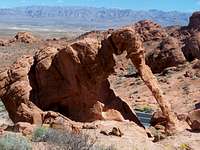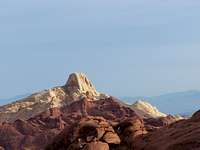-
 29592 Hits
29592 Hits
-
 94.41% Score
94.41% Score
-
 47 Votes
47 Votes
|
|
Area/Range |
|---|---|
|
|
36.43710°N / 114.532°W |
|
|
Hiking, Mountaineering, Bouldering, Mixed, Scrambling, Canyoneering |
|
|
Spring, Summer, Fall, Winter |
|
|
Overview
The Valley of Fire is Nevada's first and largest State Park. It was dedicated in 1935. The hiking and scrambling opportunities are endless. You can start from anywhere and just start scrambling, bouldering, and hiking just feeling free as a bird. Red sandstone formations and the beauty of the Desert is how it got its name. Evidence of early man and ancient trees are seen throughout the park by areas of petrified wood and 3,000 year-old Indian petroglyphs. Popular activities include bouldering, camping, hiking, picnicking, scrambling and photography. The park has a full-scale visitor center with extensive interpretive displays. Several group use areas are available as well. The park is open all year round.Plants & Animals
The Valley of Fire plant community is dominated by widely spaced creosote bush, burro bush and brittle bush. Several cactus species, including Beavertail and cholla, are also common. Springtime blooms of Desert Marigold, Indigo Bush and Desert Mallow are often spectacular along park roads.
Resident birds include the Raven, House Finch, Sage Sparrow and Roadrunner. Many migrant birds also pass through the park. Most desert animals are nocturnal and not frequently seen by visitors. Many species of lizards and snakes are common, as well as the Coyote, Kit Fox, Spotted Skunk, Black-Tailed Jackrabbit, Big Horn Sheep, and Antelope Ground Squirrel. The Desert Tortoise is a rare species and is protected by state law.
Climate
Typical low desert conditions exist. Winters are mild with temperatures ranging from freezing to 75 degrees F. Daily summer highs usually exceed 100 degrees, and may reach 120 degrees. Summer temperatures usually do not vary widely from day to night. Average annual rainfall is four inches, coming in the form of light winter showers and summer thunderstorms. Spring and fall are the preferred seasons for visiting the Valley of Fire.
Getting There
The park is located about 55 miles NE from Las Vegas. Traveling NE on Interstate 15 from Las Vegas, take Nevada Route 169 at Crystal south to the park. Traveling southwest on I-15 turn south on Route 169 (Exit 93) near Glendale, and travel southeast 15 miles to the park.Commercial air, rail and bus service are available to Las Vegas, Nevada, 50 miles southwest.
Red Tape
Since this is a State Park, National Parks passes are not accepted. For day use of the park it is $6 per vehicle. You can pay for a year pass for $60 for the park or pay $90 for access to all Nevada State Parks for $90. Paying requires filling out information and putting the money in an envelope then depositing it into the fee tube found at the park's entrance. Be sure to take your stub to show when you leave the park. The attached picture at the entrance shows the rules and fees.The park is open daily from Sunrise to Sunset. The visitor center is open from 8:30AM to 4:30PM. For more information call 702-397-2088.








Fleshj27 - May 8, 2015 4:57 pm - Voted 10/10
the price went up!Inflation has raised its ugly head and the price is now $10 for the vehicle to enter the park. Worth every penny (2015)!